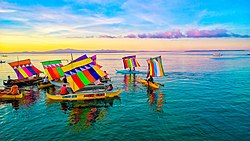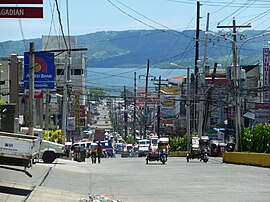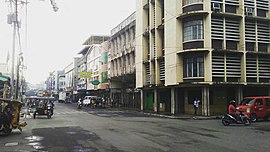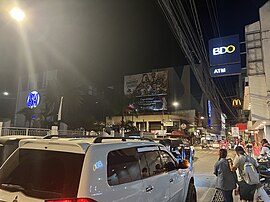Region in Mindanao, Philippines
| Zamboanga Peninsula
Peninsula de Zamboanga Lawis sa Zamboanga | |
|---|---|
| Region | |
 Vintas of Zamboanga Vintas of Zamboanga | |
 Location in the Philippines Location in the Philippines | |
| OpenStreetMap | |
| Coordinates: 7°50′N 122°25′E / 7.83°N 122.42°E / 7.83; 122.42 | |
| Country | Philippines |
| Island group | Mindanao |
| Regional center | Pagadian |
| Largest city | Zamboanga City |
| Area | |
| • Total | 17,056.73 km (6,585.64 sq mi) |
| Highest elevation | 1,532 m (5,026 ft) |
| Population | |
| • Total | 3,875,576 |
| • Density | 230/km (590/sq mi) |
| Time zone | UTC+8 (PST) |
| ISO 3166 code | PH-09 |
| Provinces | 3 |
| Independent cities | 1 |
| Component cities | 4 |
| Municipalities | 68 |
| Barangays | 1,904 |
| Cong. districts | 8 |
| Languages | |
| GDP (2023) | ₱531.7 billion $9.56 billion |
| Growth rate | |
| HDI | |
| HDI rank | 16th in the Philippines (2019) |
Zamboanga Peninsula (Cebuano: Lawis sa Zamboanga.; Chavacano: Peninsula de Zamboanga; Filipino: Tangway ng Zamboanga) is an administrative region in Mindanao, Philippines, designated as Region IX. It consists of the provinces of Zamboanga del Norte, Zamboanga Sibugay and Zamboanga del Sur, and the cities of Isabela and Zamboanga City. The region was previously known as Western Mindanao. Pagadian serves as the regional center, while Zamboanga City is the commercial and industrial center.
History
Ancient era
During the ancient era, the Zamboanga peninsula was a vast territory home to various ethnic groups – the largest of which was the Subanen people. Later on, the southern coastal areas of the region were under the influence of the Javanese Majapahit Empire, although the empire never did conquer the area.
 A view of Pagadian as seen in September 2010
A view of Pagadian as seen in September 2010 A view of downtown Dipolog as seen in October 2019
A view of downtown Dipolog as seen in October 2019 A view of downtown Zamboanga at Night in May 2023
A view of downtown Zamboanga at Night in May 2023
Sultanate of Maguindanao era
In the 14th century, the Sultanate of Sulu ruled the southwestern sections of the peninsula. By the late 15th century and early 16th century, Malay missionaries further spread Islam in the southern Philippines. Sharif Kabungsuwan, a Johore-born missionary of Malay and Arab descent established the Sultanate of Maguindanao, which the entire island of Mindanao is named after. The sultanate also occupied the entire island except present-day Caraga region, stretching from the Zamboanga Peninsula to Davao Oriental, while the Sultanate of Sulu lost its territories in Zamboanga. Maguindanao's sultans provided Mindanao fierce armed resistance against the Spanish occupation, especially under the lead of Muhammad Kudarat. They soon allied themselves with the Sulu sultanate. The Muslim natives of the region were collectively known as Moros by the Spanish, meaning "Moor", though the Iberian Moors and the Philippine Muslims had little cultural connection outside of following Islam. A large chunk of the Spanish–Moro conflict, the war between the Spanish and Mindanao's Muslim natives took place in the Zamboanga Peninsula.
Spanish rule
In 1569 Zamboanga was chosen as the site of the Spanish settlement and garrison on La Caldera (now called Barrio Recodo). Zamboanga was one of the main strongholds in Mindanao, supporting colonizing efforts in the south of the island and making way for Christian settlements. It also served as a military outpost, protecting the island against foreign invaders and Moro pirates and their Chinese allies. The province, named and centered on Zamboanga City was partly founded by Peruvian soldiers brought by Sebastián Hurtado de Corcuera.
The Zamboanga Peninsula played a central role in the Spanish–Moro conflict. It was the site of constant battling between Spanish soldiers and Moro pirate raids. While the Spanish successfully established churches in the region, they suffered heavily at the hands of Moro raiders, and had to repeatedly withdraw from the region. While the Spanish achieved a tactical victory by launching several attacks against the Sultanate of Sulu, constant fighting and attacks persisted, giving the Moros a psychological victory.
Province of Zamboanga
After the United States annexed the Spanish East Indies in 1898, the peninsula hosted a briefly independent state called the Republic of Zamboanga. It was incorporated by the Insular Government into the Moro Province, which consisted of the central and western parts of Mindanao and the Sulu Archipelago. The name and status of Moro Province were changed to the Department of Mindanao and Sulu on August 16, 1916, causing Zamboanga to become a separate province.
In 1942, the Zamboanga Peninsula along with the rest of the Philippine Islands was occupied by the Empire of Japan at the beginning of the Second World War. The Peninsula was liberated in 1945 by joint American and Philippine Commonwealth forces fighting against the Imperial Japanese Army.
On June 6, 1952, the province was partitioned into Zamboanga del Norte and Zamboanga del Sur, while the chartered city of Zamboanga became part of Zamboanga del Sur.
Region
Together with the Sulu Archipelago, the provinces that formerly made up Zamboanga Province were re-organised into Region IX by order of Presidential Decree No. 1 as part of the Integrated Reorganization Plan of President Ferdinand Marcos, that was signed on September 24, 1972.
From 1975 to 1989, the old Region IX (Western Mindanao) was further divided into two sub-regions by Presidential Decree No. 8233 dated August 21, 1975. Sub-Region IX-A consisted of Basilan, Sulu and Tawi-Tawi with Jolo, Sulu, as the sub-regional center, while Sub-Region IX-B consisted of the provinces of Zamboanga del Norte, Zamboanga del Sur and Zamboanga Sibugay, with the chartered city of Zamboanga City as the sub-regional centre.
Present
In 2001, Zamboanga Sibugay, was created from the province of Zamboanga del Sur with Ipil as the seat of government with the virtue of Republic Act No. 8973.
In the same year, the residents of Basilan opted to join the Autonomous Region in Muslim Mindanao (ARMM) in a plebiscite. However, the citizens of the capital, Isabela, did not want to join so the city remained a part of this region as a result of Executive Order No. 36 last until 2014 only.
Regional center issue
In 1978, Presidential Decree No. 1555 transferred Region IX's regional center from Jolo, Sulu to Zamboanga City.
Executive Order (EO) No. 429 was issued in 1990 by President Corazon Aquino which provided for the reorganization of the administrative regions in Mindanao. It declared that Western Mindanao would comprise Zamboanga City, Lanao del Norte, Misamis Occidental, Zamboanga del Sur, Zamboanga del Norte, Basilan, and the cities comprising those provinces. It also declared that Pagadian shall serve as the new regional center.
In 1996, President Fidel Ramos issued EO No. 325 which reorganized the Regional Development Councils. The Implementing Rules and Regulations of EO No. 325 provided that Zamboanga City is the regional center of Western Mindanao.
In 2001, President Gloria Macapagal Arroyo signed EO No. 36 which reorganized and renamed Western Mindanao to Zamboanga Peninsula. It was silent on the issue of regional government centers.
In 2004, Memorandum Circular (MC) No. 75 directed the transfer of regional offices from Zamboanga City to Pagadian citing EO No. 429 as its legal basis. However, it provided that the regional offices of the departments of Trade and Industry, Tourism, and Labor and Employment will remain in Zamboanga City, but shall establish a presence in Pagadian.
On December 22, 2010, MC No. 11 was issued imposing a moratorium on the transfer of regional offices to Pagadian. The Circular cited the high economic and social costs that the employees were experiencing in maintaining two residences and in fully transferring to Pagadian. It further directed all regional offices that are already in Pagadian to continue their operations.
On June 30, 2020, MC No. 78 was issued, repealing MC No. 11 and lifting the moratorium on the transfer of the remaining regional offices to Pagadian. The Circular affirmed that Pagadian is the regional government center while Zamboanga City is the commercial and industrial center of Region IX.
On April 19, 2023, under MC No. 18, another moratorium was imposed on the transfer of regional offices to Pagadian pending further study of its implications. The regional offices that are already in Pagadian shall continue to operate thereat.
Geography
The region is located on the western part of the island of Mindanao, that lies between the Moro Gulf (part of the Celebes Sea) and the Sulu Sea. Along the shores of the peninsula are numerous bays and islands of varying sizes. The peninsula is connected to the rest of Mindanao through an isthmus situated between Panguil Bay and Pagadian Bay. The region consists of the three Zamboanga provinces and the highly urbanized independent city of Zamboanga, and the boundary between the peninsula and mainland is artificially marked by the border between the provinces of Zamboanga del Sur and Lanao del Norte. The province of Misamis Occidental occupies the northeast corner of the geographic peninsula, but is part of the Northern Mindanao administrative region, which also includes Misamis Oriental on the Mindanao mainland, formerly both part of pre-1929 Misamis (province) along the shores of Iligan Bay.
Administrative divisions
Provinces
Zamboanga Peninsula comprises 3 Provinces; 1 independent, chartered and highly urbanized city; 3 component cities; 67 municipalities and 1,904 barangays.
Sulu, which was excluded from the Bangsamoro region, has an unclear status. The Commission on Elections en banc however had the consensus that Sulu should revert back to the Zamboanga Peninsula, the region it belonged to prior its inclusion in the ARMM back in 1989.
| Province or City | Capital | Population (2020) | Area | Density | Cities | Muni. | Barangay | |||||
|---|---|---|---|---|---|---|---|---|---|---|---|---|
| km | sq mi | /km | /sq mi | |||||||||
| Zamboanga del Norte | Dipolog City | 27.0% | 1,047,455 | 7,300.11 | 2,818.59 | 140 | 360 | 2 | 25 | 691 | ||
| Zamboanga del Sur | Pagadian City | 27.1% | 1,050,668 | 4,484.21 | 1,731.36 | 230 | 600 | 1 | 26 | 681 | ||
| Zamboanga Sibugay | Ipil | 17.3% | 669,840 | 3,481.28 | 1,344.13 | 180 | 470 | 0 | 16 | 389 | ||
| Zamboanga City | † | — | 25.2% | 977,234 | 1,414.70 | 546.22 | 690 | 1,800 | 1 | — | 98 | |
| Isabela City | ‡ | — | 3.4% | 130,379 | 233.73 | 90.24 | 560 | 1,500 | 1 | — | 45 | |
| Total | 3,875,576 | 16,904.03 | 6,526.68 | 230 | 600 | 5 | 67 | 1,904 | ||||
| ||||||||||||
Governors and vice governors
| Province | Image | Governor | Political party | Vice governor | |
|---|---|---|---|---|---|
| Zamboanga del Norte | 
|
Rosalina Jalosjos | Nacionalista/APP | Julius Napigquit | |
 Zamboanga del Sur Zamboanga del Sur
|

|
Victor Yu | PFP | Roseller Ariosa | |
 Zamboanga Sibugay Zamboanga Sibugay
|

|
Dulce Ann Hofer | PFP | Rey Andre Olegario | |
Cities

Dapitan is one of the two cities of Zamboanga del Norte. Known as the "Shrine City in the Philippines", this was where José Rizal, the national hero of the country, was exiled. It is also known for the old St. James Parish and the beach resort of Dakak.
Dipolog, capital of Zamboanga del Norte, is known for their abundance of orchids, thus it is called "Orchid City of the South" or "Orchid City". They have their nature spots and historical spots, such as Dipolog Cathedral, Dipolog Boulevard, Cogon Park, Japanese Park, Plaza Magsaysay, the Sungkilaw Falls, and the 3,003 steps to Linabo Peak.
Isabela is a component city of the province of Basilan. Until 2017, it was the capital of the said province, since then, Basilan's government was moved to Lamitan. Isabela continues to be under the jurisdiction of Basilan for the administration of provincially devolved services and functions, but for regional and statistics purposes, the city is part of Zamboanga Peninsula, in contrast to the rest of Basilan which is under BARMM. Named after Queen Isabella II, Isabela was the southernmost outpost of the Spanish Empire in the Philippines until the fall of Jolo in 1878. It hosted a Spanish fort (later destroyed in World War II) since 1848, and was the primary naval base of the Spanish in Mindanao until 1899. The city serves as an entry point for trade and commerce of Basilan island.
Pagadian is the capital of Zamboanga del Sur, as well as the region's administrative center. The city is known as the "Little Hong Kong of the South" because of its topographical feature that is reminiscent of Hong Kong. It also has an affluent Chinese community that officially celebrates the Chinese Lunar New Year.
Zamboanga City is the only highly urbanized city in the region. Geographically located at the southwestern tip of the peninsula, the city continues to be the economic and industrial center of the region, generating more than half of its economy. The city is the lone member of BIMP-EAGA in the Zamboanga Peninsula. It also has the largest airport and seaport and the city in the region with most investors.
- † Regional center
| City | Population (2020) | Area | Density | City class | Province | ||
|---|---|---|---|---|---|---|---|
| km | sq mi | /km | /sq mi | ||||
| Dapitan | 85,202 | 390.53 | 150.78 | 220 | 570 | Component | Zamboanga del Norte |
| Dipolog | 138,141 | 241.13 | 93.10 | 570 | 1,500 | Component | Zamboanga del Norte |
| Isabela | 130,379 | 140.7 | 54.3 | 930 | 2,400 | Component | Basilan |
| † Pagadian | 210,452 | 378.80 | 146.26 | 560 | 1,500 | Component | Zamboanga del Sur |
| Zamboanga City | 977,234 | 1,414.7 | 546.2 | 690 | 1,800 | Highly urbanized | Zamboanga del Sur |
Demographics
| Year | Pop. | ±% p.a. |
|---|---|---|
| 1903 | 98,086 | — |
| 1918 | 147,333 | +2.75% |
| 1939 | 355,984 | +4.29% |
| 1948 | 521,941 | +4.34% |
| 1960 | 900,730 | +4.65% |
| 1970 | 1,334,446 | +4.00% |
| 1975 | 1,541,459 | +2.93% |
| 1980 | 1,821,751 | +3.40% |
| 1990 | 2,280,460 | +2.27% |
| 1995 | 2,567,651 | +2.25% |
| 2000 | 2,831,412 | +2.12% |
| 2007 | 3,230,094 | +1.83% |
| 2010 | 3,407,353 | +1.96% |
| 2015 | 3,629,783 | +1.21% |
| 2020 | 3,875,576 | +1.30% |
| Source: Philippine Statistics Authority | ||
Economy
| This section does not cite any sources. Please help improve this section by adding citations to reliable sources. Unsourced material may be challenged and removed. (June 2022) (Learn how and when to remove this message) |
Poverty incidence of Zamboanga Peninsula
|
10
20
30
40
50
2006 44.96 2009 45.77 2012 40.11 2015 37.69 2018 32.7 2021 23.40 Source: Philippine Statistics Authority |
The Philippine Statistics Authority (PSA) released the first ever report of the Provincial Product Accounts (PPA) of Zamboanga Peninsula covering the period 2018 to 2022. The release covers three provinces, namely, Zamboanga del Norte, Zamboanga del Sur, and Zamboanga Sibugay, as well as the cities of Zamboanga and Isabela. The PPA results showed that in 2022, the city of Zamboanga accounted for 32.6 percent of the region's total economy, followed by Zamboanga del Norte with a share of 26.8 percent, Zamboanga del Sur with 23.7 percent, and Zamboanga Sibugay with 14.1 percent. Meanwhile, the city of Isabela recorded a 2.7 percent share.
In terms of growth rate, all economies in the region expanded in 2022, with Zamboanga Sibugay recording the fastest growth of 8.6 percent, followed by city of Zamboanga with a growth rate of 8.1 percent, both of which were higher than the region's economic growth of 7.5 percent. On the other hand, the city of Isabela, Zamboanga del Norte, and Zamboanga del Sur posted growth rates of 7.21 percent, 7.17 percent, and 6.5 percent, respectively.
The region has the first export-processing zone in Mindanao. Farming and fishing are the main economic activities of the region. It also has rice and corn mills, oil processing, coffee berry processing and processing of latex from rubber. Its home industries include rattan and furniture craft, basket making, weaving and brass work. Dipolog is home to a number of Bottled Sardines Companies which are being exported abroad. Meanwhile, Dapitan is home to several tourist spots, such as Dakak Park and Beach Resort, Rizal Shrine, and Glorious Fantasyland, one of the very few amusement parks located in Mindanao.
While Pagadian is the region's new regional center, Zamboanga City’s economy remains to be the most robust and fastest growing in the region. Zamboanga City also retains the title of being the commercial and industrial center of the region.
Resources
The region has vast forest resources and previously used to export logs, lumber, veneer and plywood. Mineral deposits include gold, chromite, coal, iron, lead, and manganese. Among its non-metallic reserves are coal, silica, salt, marble, silica sand, and gravel. Its fishing grounds are devoted to commercial and municipal fishing. It has also aqua farms for brackish water and freshwater fishes.
Area of Growth
The economic fulcrum of the region lies at the center of the peninsula that is the area connecting Ipil and Liloy. Along with its premiere towns of Sindangan and Molave, it has the fastest economic activity of the region. The 50-kilometer link between the north and the south would act as the main artery of economy in the region.
Shopping malls
Lists of national malls in Zamboanga Peninsula (operating or under construction)
| Name | Location | Gross floor area | Opened | Status | Remarks |
|---|---|---|---|---|---|
| Gaisano Capital Pagadian | Rizal Avenue, Pagadian, Zamboanga del Sur | 46,307 m | 2008 | Operating | First Gaisano Capital in the region. |
| CityMall Tetuan | Don Alfaro Street, Tetuan, Zamboanga City | 15,344 m | 2015 | Operating | First CityMall in the region and in Zamboanga City. |
| KCC Mall de Zamboanga | Camins Avenue, Zamboanga City | 162,000 m | 2015 | Operating | First KCC Mall and the largest mall in the region. |
| CityMall Dipolog | Sto. Filomena, Dipolog, Zamboanga del Norte | 12,862 m | 2018 | Operating | First CityMall in Zamboanga del Norte. |
| SM City Mindpro | La Purisima Street, Zamboanga City | 59,383 m | 2020 | Operating | First SM mall in the region. Originally Mindpro Citimall, it was acquired by SM Prime Holdings last 2016. |
| Gaisano Grand Ipil | Ipil, Zamboanga Sibugay | 53,985 m | 2023 | Operating | First Gaisano Grand mall in the region, and first national-scale mall in Zamboanga Sibugay. |
| Gaisano Capital Molave | Molave, Zamboanga del Sur | 13,206 m | TBD | On-hold | The second Gaisano Capital in Zamboanga del Sur and in the region. |
| Robinsons Pagadian | Pagadian, Zamboanga del Sur | 57,221 m | 2024 | Under-construction | Set to become the first Robinsons mall in the region. |
| Grand CityMall Guiwan | Guiwan, Zamboanga City | 33,814 m | 2024 | Under-construction | The second CityMall in Zamboanga City, and the third in the region. Set to become the largest CityMall in the country. |
| SM City Zamboanga | Vitaliano Agan Avenue, Zamboanga City | 110,055 m | 2024 | Under-construction | The second SM Supermall in Zamboanga City and in the region. |
| Gaisano Grand Dipolog | Sto. Filomena, Dipolog, Zamboanga del Norte | TBA | TBD | Under-construction | Set to become the first Gaisano Grand mall in Zamboanga del Norte. |
Infrastructure
Airports
- Dipolog Airport – is the main airport serving the general area of Dipolog, the capital city of Zamboanga del Norte, in the Philippines. It is classified as a Class 1 principal (major domestic) by the Civil Aviation Authority of the Philippines. (CAAP)
- Pagadian Airport – is the airport serving the city of Pagadian, the rest of the province of Zamboanga del Sur, and the province of Zamboanga Sibugay in the Philippines. It is classified as a Class 1 principal (major domestic) by the Civil Aviation Authority of the Philippines. (CAAP)
- Zamboanga International Airport – is the main airport serving Zamboanga City in the Philippines. Located on a 270-hectare (670-acre) site in Barangay Canelar, Zamboanga City, the airport is Mindanao's third-busiest airport. Despite being billed as an international airport, It is classified as a Class 1 principal (major domestic) by the Civil Aviation Authority of the Philippines. (CAAP) The airport is planned to be transferred to Mercedes by 2030, approximately 17 km away from the city's Central Business District.
Seaports
- Port of Dapitan – It is owned and managed by Philippine Ports Authority and is the baseport of the Port Management Office Zamboanga del Norte.
- Port of Pagadian – it recently restarted its operations.
- Ipil Port
- Port of Zamboanga – it is managed by the Philippine Ports Authority, Zamboanga Freeport Authority (ZFA). it is a center for sardine exports to the United States, Europe, the Middle, and Far East. 25 shipping lines operate via the port, serviced by four shipyards operating within the port boundaries and in Zamboanga City.
Roads and Bridges
- Zamboanga City By-Pass Road – This by-pass road is a 36.77 km with a 12 meter wide, 2 lane road with slope protection, the route starts at the junction of MCLL National Highway and Barangay Culianan, traversing Barangay Culianan – Sinubong. The project was started on January 9, 2012, and was completed on December 28, 2018.
- Pan-Philippine Highway (AH26) - Section of AH26 passes Zamboanga del Sur and Zamboanga Sibugay, with Zamboanga City being its terminus.
Notable people
Main pages: Zamboanga del Norte § Notable people, Zamboanga del Sur § Notable people, Category:People from Zamboanga City, Zamboanga City § Notable personalities, and Zamboanga Sibugay § Notable peopleReferences
- ^ Census of Population (2015). "Region IX (Zamboanga Peninsula)". Total Population by Province, City, Municipality and Barangay. Philippine Statistics Authority. Retrieved June 20, 2016.
- ^ "2021 to 2023 Gross Regional Domestic Product (GRDP)". openstat.psa.gov.ph. Philippine Statistics Authority. Retrieved April 26, 2024.
- ^ "E.O. No. 429". The LawPhil Project. October 12, 1990. Retrieved June 18, 2012.
- "SECOND BOOK OF THE SECOND PART OF THE CONQUESTS OF THE FILIPINAS ISLANDS, AND CHRONICLE OF THE RELIGIOUS OF OUR FATHER, ST. AUGUSTINE" (Zamboanga City History) "He (Governor Don Sebastían Hurtado de Corcuera) brought a great reënforcements of soldiers, many of them from Perú, as he made his voyage to Acapulco from that kingdom."
- "P.D. No. 1 1972".
- "P.D. No. 773".
- "Presidential Decree No. 1555: Further Amending Presidential Decree No. 742 as amended by Presidential Decree No. 773 transferring the regional center of Region IX from Jolo to Zamboanga City". The LawPhil Project. June 11, 1978. Retrieved June 12, 2020.
- ^ "Palace halts regional transfer". SunStar.com.ph. December 27, 2010. Archived from the original on January 31, 2011. Retrieved May 23, 2016.
- "E.O. 36". The LawPhil Project. August 12, 2015. Retrieved June 18, 2016.
- "Memorandum Circular No. 75, s. 2004". Official Gazette of the Republic of the Philippines. November 12, 2004. Retrieved June 12, 2020.
- "Memorandum Circular No. 11, s. 2010". Official Gazette of the Republic of the Philippines. December 22, 2010. Retrieved June 18, 2012.
- Memorandum Circular No. 78 (June 30, 2020), Repealing Memorandum Circular No. 11 (S. 2010) And Directing The Transfer Of Regional Offices Of National Government Agencies In Region IX From Zamboanga City To Pagadian City Pursuant To Executive Order No. 429 (S. 1990), The LawPhil Project, retrieved September 15, 2024
- Memorandum Circular No. 18 (April 19, 2023), RMposing A Moratorium On The Transfer Of National Government Regional Offices From Zamboanga City To Pagadian City Pursuant To Memorandum Circular (Mc) No. 78 (S. 2020), The LawPhil Project, retrieved September 15, 2024
- "BARMM services in Sulu to continue amid SC ruling". GMA Regional TV. September 12, 2024. Retrieved September 12, 2024.
- Depasupil, William (September 13, 2024). "Comelec to place Sulu in Region 9". The Manila Times. Retrieved September 13, 2024.
The leaning of the Commission en banc is to include it for this election in Region 9,
- Umel, Richel; Dela Cruz, Sheila Mae (September 13, 2024). "BARMM execs seek help to deal with Sulu's exit". INQUIRER.net. Retrieved September 13, 2024.
Another is to which administrative region Sulu will belong to. The nearest to it is the Zamboanga Peninsula (Region 9), to which Lamitan City in Basilan, which is not part of the BARMM, belongs.
- ^ Census of Population (2020). "Region IX (Zamboanga Peninsula)". Total Population by Province, City, Municipality and Barangay. Philippine Statistics Authority. Retrieved July 8, 2021.
- "List of Provinces". PSGC Interactive. Makati, Philippines: National Statistical Coordination Board. Archived from the original on January 11, 2013. Retrieved July 15, 2014.
- "Dapitan City Official Website".
- "History – CITY OF ISABELA | Official Website". Retrieved June 26, 2024.
- Facts about Pagadian Archived February 11, 2009, at the Wayback Machine (retrieved: April 12, 2009)
- "Population and Annual Growth Rates for The Philippines and Its Regions, Provinces, and Highly Urbanized Cities" (PDF). 2010 Census and Housing Population. Philippine Statistics Authority. Archived from the original (PDF) on September 28, 2013. Retrieved August 12, 2013.
- "Poverty incidence (PI):". Philippine Statistics Authority. Retrieved December 28, 2020.
- "Estimation of Local Poverty in the Philippines" (PDF). Philippine Statistics Authority. November 29, 2005.
- "2009 Official Poverty Statistics of the Philippines" (PDF). Philippine Statistics Authority. February 8, 2011.
- "Annual Per Capita Poverty Threshold, Poverty Incidence and Magnitude of Poor Population, by Region and Province: 1991, 2006, 2009, 2012 and 2015". Philippine Statistics Authority. August 27, 2016.
- "Annual Per Capita Poverty Threshold, Poverty Incidence and Magnitude of Poor Population, by Region and Province: 1991, 2006, 2009, 2012 and 2015". Philippine Statistics Authority. August 27, 2016.
- "Annual Per Capita Poverty Threshold, Poverty Incidence and Magnitude of Poor Population, by Region and Province: 1991, 2006, 2009, 2012 and 2015". Philippine Statistics Authority. August 27, 2016.
- "Updated Annual Per Capita Poverty Threshold, Poverty Incidence and Magnitude of Poor Population with Measures of Precision, by Region and Province: 2015 and 2018". Philippine Statistics Authority. June 4, 2020.
- "2021 Full Year Official Poverty Statistics of the Philippines" (PDF). Philippine Statistics Authority. August 15, 2022. Retrieved April 28, 2024.
- Philippine Statistics Authority. "City of Zamboanga Accounts for One-Third of Zamboanga Peninsula's Economy; Zamboanga Sibugay Posts the Fastest Growth with 8.6 Percent".
- Sunstar Philippines. "Zamboanga City economy grows by P139.47-B".
- Regional Development Council IX, and National Economic and Development Authority (May 23, 2023). "Zamboanga Peninsula Regional Development Plan 2023-2028" (PDF).
- "Zamboanga Peninsula Regional Development Plan 2023–2028" (PDF). Regional Development Council and National Economic and Development Authority. Retrieved May 24, 2023.
- "BIZ BUZZ: DoubleDragon within striking distance". Philippine Daily Inquirer. August 2023.
- "Zamboanga City By-Pass Road". Retrieved August 8, 2019.
External links
- [REDACTED] Media related to Zamboanga Peninsula at Wikimedia Commons
 Zamboanga Peninsula travel guide from Wikivoyage
Zamboanga Peninsula travel guide from Wikivoyage- [REDACTED] Geographic data related to Zamboanga Peninsula at OpenStreetMap

| Regions adjacent to Zamboanga Peninsula | ||||||||||||||||
|---|---|---|---|---|---|---|---|---|---|---|---|---|---|---|---|---|
| ||||||||||||||||
| Regions of the Philippines | |
|---|---|
| Luzon | |
| Visayas | |
| Mindanao | |
| Former regions | |
